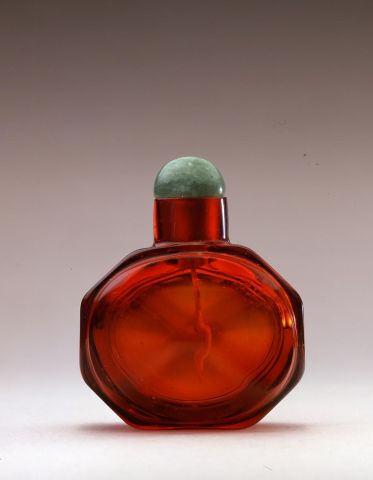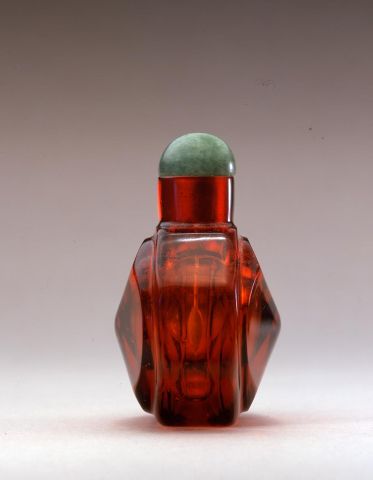

Bottle ID: 00104
RED RUBY, OCTAGONAL, CARVED W/RAISED PANELS
Date: 1730-1780
Height: 47 mm
Glass, of octagonal faceted form, with raised panels on the front and reverse, blown and carved as diagonally segmented quatrefoils, the straight neck ending in a wide mouth, of ruby-red tone.
Imperial, attributed to the Palace Workshops, Beijing.
Similar Examples:
Crane Collection no. 274
Lawrence, Clare. Miniature Masterpieces from the Middle Kingdom - The Monimar Collection of Chinese Snuff Bottles, 1996, pp. 218-219, no. 103.217.
Moss, Hugh, Victor Graham and Ka Bo Tsang. A Treasury of Chinese Snuff Bottles - The Mary and George Bloch Collection, 2002, Vol. 5, Part 2, p. 304, no. 805.
Provenance:
Clare Lawrence Ltd.
The Thewlis Collection
Forbidden City Antiques, Hong Kong, July 8, 1970
Exhibited:
Annual Convention ICSBS Toronto, October 2007
Published:
Lawrence, Clare. The Thewlis Collection of Chinese Snuff Bottles, 1990, p. 37, no. 54
Traditionally, one assumes that it was through enamel-work in the Imperial workshops that the influence of the Europeans present at Court can be seen. However, it was not only material skills and decoration that were taken from the Europeans. The form of one particular group of eighteenth century glass bottles rests solely in the laps of the Europeans. While faceting as a form is stylistically Western, taken from the French and Swiss, the technique of faceting in the eighteenth century was clearly Chinese. The bottles would have been mold- blown, then cut and polished using similar techniques to the jade carvers of the time. This ruby-red glass snuff bottle of small octagonal faceted form would have been made by this method. The intention of faceting in Europe was in the cutting of gems to show brilliance in the stone. This does not appear to be the case for the Chinese as the technique was used not only on glass, but also on jade which is opaque. As the workers quickly developed their skills, their innovative approach satisfied the need at Court for novelty.
As the century progressed these small, finely made examples became softer around the edges, and by the beginning of the nineteenth century, bigger in size. From its size, form, color and particular characteristics such as the width of the mouth, this example can be given an attribution to the eighteenth century and its place of manufacture as the Imperial workshops, the Zaobanchu.

 English
English 中文
中文